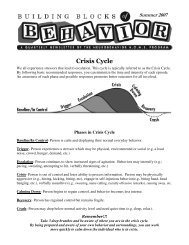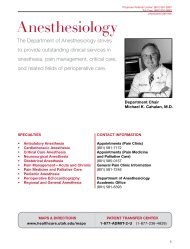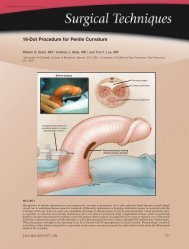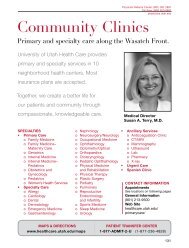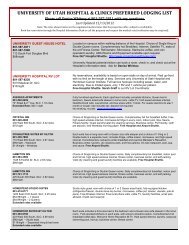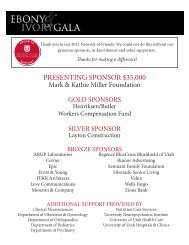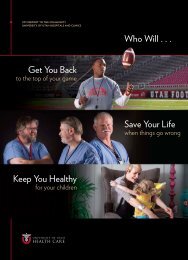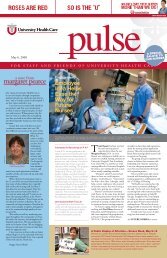Dress Code Policy Purpose - University of Utah Health Care
Dress Code Policy Purpose - University of Utah Health Care
Dress Code Policy Purpose - University of Utah Health Care
Create successful ePaper yourself
Turn your PDF publications into a flip-book with our unique Google optimized e-Paper software.
<strong>Dress</strong> <strong>Code</strong> <strong>Policy</strong><br />
<strong>Purpose</strong>:<br />
A. The <strong>University</strong> <strong>of</strong> <strong>Utah</strong> Hospitals and Clinics has established a Pr<strong>of</strong>essional Image Standard,<br />
which outlines dress and grooming guidelines to promote a consistent pr<strong>of</strong>essional image<br />
throughout the organization and to help customers and employees feel safe, confident and<br />
comfortable.<br />
Definitions:<br />
<strong>Policy</strong>:<br />
A. Patient <strong>Care</strong> Area- Any area in which patients are present for clinical reasons. This includes<br />
the entrance to any unit or clinic, nursing stations, patient rooms, and reception/waiting<br />
areas.<br />
A. This policy applies to any employee who is at work as part <strong>of</strong> his / her regular duties and is<br />
representing the organization to the public.<br />
B. As an employee <strong>of</strong> the <strong>University</strong> <strong>of</strong> <strong>Utah</strong> <strong>Health</strong> <strong>Care</strong>, you are expected to maintain a<br />
pr<strong>of</strong>essional image while working in the clinics, health care areas, <strong>of</strong>fice, and while<br />
attending company events, seminars, training, conferences or meetings on campus or <strong>of</strong>fsite.<br />
It is vital for the safety and security <strong>of</strong> our staff, patients and their families that<br />
employees follow and adhere to the company's pr<strong>of</strong>essional and uniform dress standards.<br />
C. This policy outlines the minimum requirement for pr<strong>of</strong>essional appearance. A<br />
manager/supervisor shall retain the discretion to set standards at a higher level for<br />
employees, based on patient contact or job function. Higher standards should be<br />
communicated in unit/department orientation, evaluated in performance evaluation, and<br />
reviewed annually or as appropriate.<br />
D. Groups requesting exceptions to the policy should contact their direct managers. Final<br />
decisions will be made by the Operations Council. Individuals requesting an accommodation<br />
or exemption should contact their Human Resources Representative. The <strong>University</strong> <strong>of</strong> <strong>Utah</strong><br />
is an equal opportunity employer and is fully committed to the principle <strong>of</strong><br />
nondiscrimination in all employment related practices and decisions.<br />
See http://www.regulations.utah.edu/humanResources/5-106.html
IMPLEMENTATION:<br />
A. <strong>Dress</strong> Standards<br />
1. Listed below are the acceptable and unacceptable clothing styles in the workplace.<br />
Clothing Style Reference Acceptable Unacceptable<br />
Tops Sleeves 1.0 Tops any sleeve length except<br />
sleeveless*.<br />
*<strong>Dress</strong>y silk knit sleeveless shells,<br />
tanks or tops may be worn only if<br />
under a jacket or sweater.<br />
Tops Styles 2.0 Pr<strong>of</strong>essional business shirts with<br />
collars are preferred.<br />
Button-down or pull-over shirts<br />
with collars (i.e., Polo or Golf<br />
shirts, Oxford, Shell, Turtleneck,<br />
etc.).<br />
Tops without collars should be<br />
tailored and made <strong>of</strong> quality,<br />
firmer fabrics that hold their<br />
shape, and be in good condition.<br />
Tops and blouses in conservative<br />
colors and moderate styles.<br />
Pull-over and button-down<br />
sweaters in good condition.<br />
Cardigan sweater sets.<br />
Sleeveless tops <strong>of</strong> any<br />
kind including tube-tops,<br />
tank tops, spaghetti-strap,<br />
halter tops and athletic<br />
tops. Bare shoulders or<br />
back are not permitted at<br />
any time.<br />
Scrub tops unless working<br />
in clinical area.<br />
Gym or yoga tops or<br />
faded, old or tight-fitting<br />
cotton t-shirts.<br />
Lacy camisole, sequined<br />
tops, or tops made <strong>of</strong> seethrough<br />
revealing fabrics.<br />
Tropical camp shirts,<br />
oversized baggy<br />
sweaters, denim shirts,<br />
flannel or pajama style<br />
tops.<br />
Shirts with silkscreen<br />
logos or printing <strong>of</strong> any<br />
kind excluding approved<br />
shirts with company logo).<br />
Neon bright colored tops<br />
or wild, abstract prints
Tops Styles 2.1 Modest tops only. Tops that reveal the<br />
abdomen when standing,<br />
lifting or bending over.<br />
Tops Styles 2.2 Tops that fit appropriately and<br />
look pr<strong>of</strong>essional.<br />
Tops worn tucked in.<br />
Tops worn un-tucked must be<br />
pr<strong>of</strong>essional in nature and<br />
designed to be worn un-tucked<br />
(i.e., men collared camp-shirts<br />
that have a straight hemline or<br />
women shell tops or tailored<br />
button down shirts with round<br />
hemlines).<br />
Jackets 3.0 Suit-like jacket styles.<br />
Casual sport jacket styles in<br />
conservative colors and classic<br />
styles (i.e., Safari jackets, suede<br />
jackets, cotton casual jackets).<br />
Tops that expose the<br />
cleavage, bra, back,<br />
shoulder, chest, lower back<br />
or under garments is not<br />
allowed. Tops with buttons<br />
or snaps must stay closed<br />
and lay flat and not expose<br />
the abdomen, chest or bra<br />
from side or front.<br />
Tops made <strong>of</strong> sheer or<br />
revealing fabric<br />
Tight, clingy, over-sized, or<br />
excessively baggy-fitting<br />
tops.<br />
Wrinkled, shrunk, faded,<br />
stained (including under<br />
arms), or worn-out tops.<br />
Tops worn un-tucked that<br />
are not designed to do so<br />
(i.e., rugby tops, jersey tops,<br />
dressy button down shirts,<br />
etc.)<br />
*Any top that does not<br />
meet Fitting Standards or<br />
Clothing Maintenance<br />
Standards<br />
Sweatshirts or "hoodies" <strong>of</strong><br />
any kind worn inside work<br />
areas. Denim, team, ski or<br />
gym jackets.<br />
Fleece jackets or vests are<br />
not allowed in clinical or<br />
patient care areas.
<strong>Dress</strong>es 4.0 <strong>Dress</strong>es that appear pr<strong>of</strong>essional<br />
and tailored (i.e., Coat-dress, shirt<br />
dress with collar, etc.)<br />
<strong>Dress</strong>es with modest necklines<br />
and hemlines (may not be higher<br />
than 2" above the knee when<br />
sitting).<br />
Skirts 5.0 Casual and dressy skirts in<br />
moderate colors, patterns and<br />
styles.<br />
Skirts with modest hemlines (May<br />
not be 2" above the knee when<br />
sitting).<br />
Pants Styles 6.0 Classic tailored slacks, pants, or<br />
trousers.<br />
Pants made <strong>of</strong> firmer fabric to<br />
maintain a pr<strong>of</strong>essional<br />
appearance (i.e., wool, cotton,<br />
and twill). Corduroy if not faded or<br />
worn looking. Linen if pressed<br />
and not wrinkled.<br />
Sundresses, tank dresses,<br />
flannel dresses, sheer or<br />
revealing evening dresses,<br />
denim dresses, back-less or<br />
strapless dresses <strong>of</strong> any<br />
kind.<br />
Any dress that stops at midthigh<br />
or with high immodest<br />
slits<br />
Denim, leather, flannel or<br />
neon colored, costume style<br />
skirts.<br />
Mini skirts, skirts above<br />
approved knee length or<br />
that stop at mid-thigh.<br />
See-through skirts worn<br />
without lining or a slip.<br />
Denim jeans <strong>of</strong> any kind or<br />
color.<br />
Leather pants, cargo pants,<br />
shorts <strong>of</strong> any length, cut<strong>of</strong>fs,<br />
overalls, yoga, aerobic<br />
or sweat pants.<br />
Scrub bottoms if not a<br />
clinical worker.<br />
Trendy pants <strong>of</strong> extreme<br />
styles including extra wide<br />
or extremely tight, narrow<br />
pant legs.<br />
Faded, torn or stained pants<br />
<strong>of</strong> any kind.
Pants Fit 6.1 Pants in good condition, wrinklefree<br />
and fit well.<br />
Footwear Shoes 7.0 Business pr<strong>of</strong>essional shoes in<br />
good, clean condition including:<br />
Pumps, flats, espadrilles, boots,<br />
loafers, and other leather shoes.<br />
Closed-toe dress shoes with<br />
moderate heel height (3" or less).<br />
<strong>Dress</strong>y Peep-Toe shoes permitted<br />
in non-patient care areas only.<br />
Noise resistant shoe soles/ heels<br />
are preferred.<br />
Footwear Shoes 7.1 Closed-toe casual shoes that<br />
are in good, polished condition<br />
and are conservative in style and<br />
in darker color tones. Athletic<br />
shoes and work boots in quality<br />
condition and in neutral color<br />
tones are acceptable for<br />
approved departments including<br />
Loading Dock or clinical areas.<br />
Footwear Crocs 7.2 Crocs in dark or neutral colors<br />
(i.e., black, navy) for approved<br />
clinical staff and clinical areas<br />
only.<br />
Pant hemlines that touch or<br />
drag on the ground.<br />
Baggie pants worn below<br />
the hips or that expose<br />
underwear.<br />
Shrunk or tight pants <strong>of</strong> any<br />
kind. Pants may not pull<br />
tight up and around the<br />
bottom, leg or abdomen<br />
areas. Pockets and pleats<br />
should lay flat and not pull<br />
open<br />
Footwear that does not<br />
comply with department<br />
specific safety regulations.<br />
Open toe shoes <strong>of</strong> any kind<br />
(including sandals), slippers,<br />
or bare feet.<br />
Flip-flops <strong>of</strong> any kind<br />
including thong-style flip<br />
flops, beachwear flip flops,<br />
yoga flip-flops, etc.<br />
Platform or chunky rubber<br />
soled shoes.<br />
Dirty, odor-ridden, worn,<br />
stained, or bright athletic<br />
shoes including yoga,<br />
running, sports, etc.<br />
.<br />
Bright, extreme colored<br />
crocs (i.e., orange, pink)<br />
worn with scrubs or pants <strong>of</strong><br />
any kind.<br />
Crocs with accessories or<br />
holes.
Footwear Leg<br />
Covering<br />
7.3 Stockings and hosiery in neutral<br />
conservative colors and styles.<br />
Solid colored leggings in neutral,<br />
conservative colors (i.e., black,<br />
charcoal) if worn with matching<br />
shoe and pant or skirt color (i.e.,<br />
brown shoes, brown leggings and<br />
brown tweed skirt).<br />
Jewelry 8.0 Jewelry including necklace, rings<br />
and earrings that are conservative<br />
in style, size and color.<br />
Jewelry 8.1 Limit two rings per hand in<br />
conservative style and color.<br />
Jewelry Body<br />
Piercing<br />
8.2 Limit two earrings per ear lobe in<br />
conservative colors and size.<br />
Ear gages should be plugged<br />
closed with plugs matching skin<br />
tone.<br />
Tattoos 9.0 Clothing styles must cover all<br />
visible tattoos.<br />
Leggings or stockings in<br />
bright colors or bold, busy,<br />
print styles, leggings worn<br />
as pants (eg, not under<br />
matching skirt).<br />
Fishnet stockings, dirty or<br />
odor-ridden socks.<br />
"Clangy" or distracting<br />
jewelry <strong>of</strong> any kind<br />
(including loud bracelets or<br />
bangles).<br />
Large, chunky, bright neon<br />
plastic rings or gaudy metal<br />
rings<br />
Bold, bright (i.e., neon<br />
colors) or excessive<br />
costume style earrings <strong>of</strong><br />
any kind. Large chandelier<br />
or hoop earrings greater<br />
than approximately 1.5<br />
inches in diameter or<br />
approximately 1.5 inches in<br />
length<br />
Earrings worn on upper ear<br />
area.<br />
Exposed eyebrow, tongue,<br />
cheek, lip, nose, chest, back<br />
or belly piercing is<br />
prohibited<br />
Visible tattoos on the body<br />
such as chest, neck, arm,<br />
abdomen, back and ankle<br />
tattoos.
Employee Badges 10.0 Badges worn above the bottom <strong>of</strong> the<br />
sternum and at eye-level, free<br />
from distracting stickers, pins, etc.<br />
Photo ID must be legible and visible at<br />
all times.<br />
Nursing Uniform 11.0 RNs and LPNs:<br />
White shirt or scrub top which<br />
meets <strong>Dress</strong> <strong>Code</strong> and Fit standards as<br />
described above including<br />
Cotton/knit shirts, polo shirts, button<br />
down shirts and/or blouses<br />
White scrub jackets may be worn as long<br />
as they comply with all other dress code<br />
standards.<br />
Scrub pants in red, black or navy which<br />
meet standards outlined in this policy.<br />
Nursing Assistants and Medical<br />
Assistants:<br />
Scrub pants in either red, black, or navy<br />
which meet standards outlined in this<br />
policy<br />
Scrub tops and pants that meet dress<br />
code and fit standards outlined in this<br />
policy.<br />
Scrub tops and pants must be in the<br />
same colors.<br />
Scrub jackets must be in the same color<br />
as the tops and pants.<br />
Scrub jackets may be worn as long as<br />
they comply with all other dress<br />
code standards.<br />
Badges worn at or<br />
below the bottom <strong>of</strong><br />
the sternum or that<br />
are not visible to staff<br />
and patients.<br />
Pins, stickers and<br />
other distracting<br />
adhesives.<br />
Lanyards used to hold<br />
ID badges are not<br />
permitted<br />
Sweatshirts, hoodies,<br />
fleece jackets.<br />
Any clothing that is<br />
dirty, ill-fitting or fails<br />
to meet the standards<br />
outlined in this policy.<br />
RNs & LPNs:<br />
Shirts, tops or scrub<br />
jackets in color other<br />
than white including<br />
shirts worn under<br />
scrub tops or scrub<br />
jackets.<br />
T-shirts, unless white<br />
and worn under<br />
underneath scrub<br />
tops.<br />
Nursing Assistants<br />
and medical<br />
Assistants:<br />
T-shirts, unless worn<br />
under scrub top or<br />
scrub jacket.
B. Grooming Standards<br />
1. Grooming is essential for the overall pr<strong>of</strong>essional appearance <strong>of</strong> all employees. In a hospital<br />
environment, including all clinical and non clinical areas, it is important for employees to be<br />
clean and well kempt. Co-workers are also affected when working with employees who have<br />
bad breath, dirty hair and body odor, etc. Listed below are required grooming practices in the<br />
workplace:<br />
Grooming Technique Reference Acceptable Unacceptable<br />
Body Odor 1.0 Must practice personal<br />
hygiene and be free <strong>of</strong><br />
<strong>of</strong>fensive odor.<br />
Hair Head 2.0 Must practice personal<br />
hygiene and hair must be<br />
neat and clean.<br />
If working in a clinical<br />
environment, long hair must<br />
be tied back to avoid patient<br />
contact during patient care<br />
and / or transportation.<br />
Hair colors must be <strong>of</strong><br />
natural tones.<br />
Hair Face 2.1 Nose and ear hair must be<br />
trimmed and maintained.<br />
Facial hair including<br />
mustache and beard must<br />
be short and neatly trimmed<br />
and maintained.<br />
Face Makeup 3.0 Make-up must appear<br />
pr<strong>of</strong>essional and natural<br />
and should be conservative<br />
in styles and colors.<br />
Perfume or cologne that<br />
might interfere with<br />
those who are ill or<br />
allergic to such odors or<br />
fragrances, particularly in<br />
patient care<br />
areas.<br />
Clothing and body with<br />
smoke odor.<br />
Extreme trends such as<br />
dreadlocks, Mohawks and<br />
long spiked hair is not<br />
acceptable.<br />
Non-natural colors such<br />
as pink, blue etc. are not<br />
acceptable.<br />
Excessive beard<br />
or mustaches styles (i.e.,<br />
braided beard hair).<br />
Frosted, bright colored<br />
eye shadow (i.e., bright<br />
green, purple, pink, etc.)<br />
Bright or excessively<br />
dark, thick eye liner worn<br />
under the eye or on top<br />
<strong>of</strong> the eyelid.
Head Gear 4.1 No hats or head coverings<br />
may be worn inside (except<br />
for approved departments<br />
and for those worn for<br />
religious and/or medical<br />
purposes).<br />
Face Glasses 4.2 Reading glasses in<br />
conservative colors and<br />
styles that are not<br />
distracting to our<br />
pr<strong>of</strong>essional appearance.<br />
Fingernail 5.0 Fingernails must be clean,<br />
neatly trimmed, and filed to<br />
avoid harming patients or<br />
other employees.<br />
Fingernail polish in<br />
conservative colors may be<br />
worn.<br />
Clinical staff: Short, natural<br />
(not artificial) fingernails are<br />
allowed.<br />
Music headphones or<br />
other distracting headgear<br />
may not be worn in<br />
public areas<br />
Sunglasses worn inside<br />
the workplace<br />
Extremely long nails and<br />
neon or distracting<br />
colors are not<br />
acceptable.<br />
Artificial nails may not be<br />
worn in clinical areas.<br />
C. Discipline<br />
1. Failure to comply with this policy will result in disciplinary action up to and including termination.



